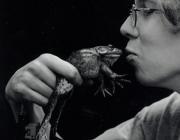Citation:
Abstract:
Sexually selected traits are thought to impose survival costs on showy males. Recent empirical work found a negative relationship between male display and survival in a field cricket species (Orthoptera, Gryllidae, Gryllinae) where there is no evidence of a mating bias toward older males. In most species, however, male survival and ornamentation are positively correlated, and older males often have a mating success advantage over younger males. These findings suggest that male quality and survival are positively correlated, but more tests of this hypothesis are needed. We measured the condition dependence of male survival and calling effort in another grylline, Gryllus pennsylvanicus, where older males have previously been shown to have greater mating success. We varied condition by manipulating diet, and measured male life span and calling effort to assess the relative condition dependence of these traits. High- and medium-condition males survived longer than low-condition males, and high-condition males called more than medium- and low-condition males. Differences in calling effort among the condition treatments were not apparent early in life, but emerged as males aged. We discuss possible explanations for the differences between our study and contrasting results such as the previous grylline work.


